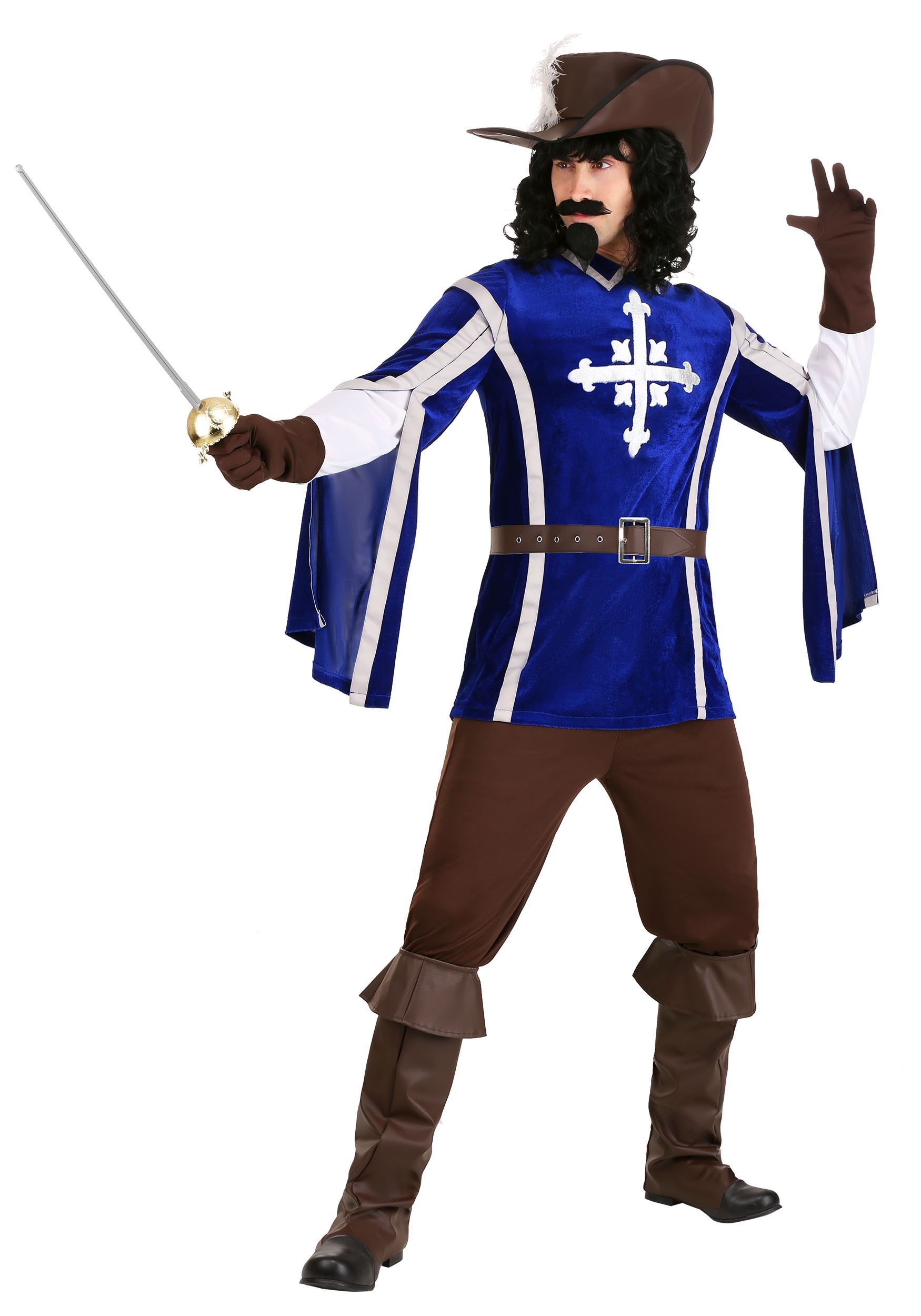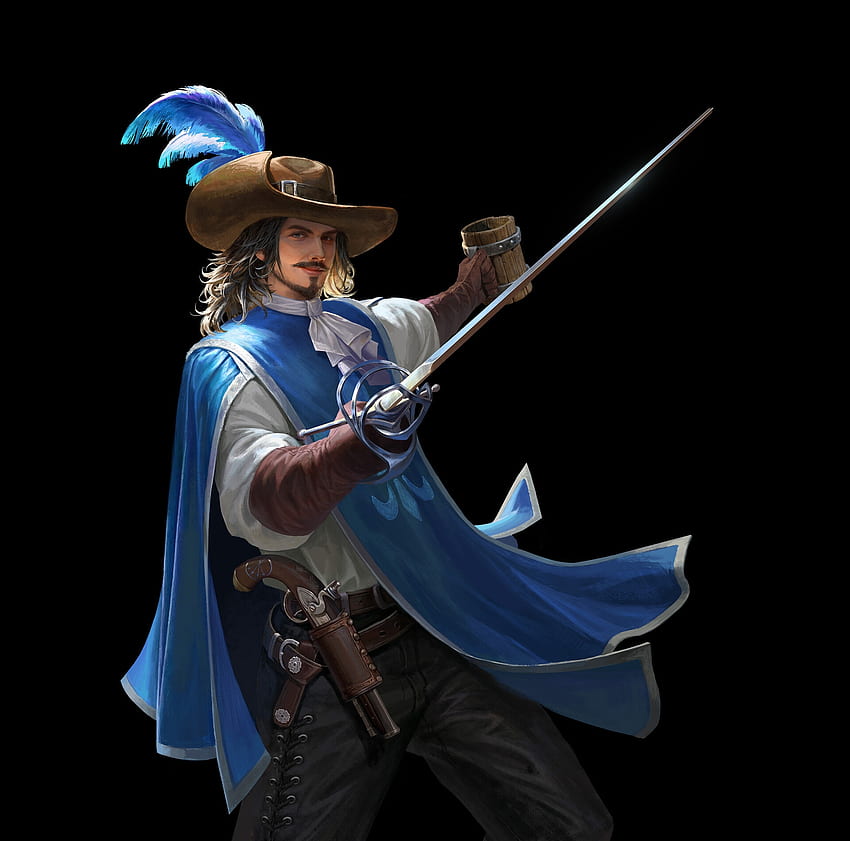Have you ever wondered about the distinctive facial hair that graces the faces of heroes in tales of swashbuckling adventure? The musketeer mustache, with its elegant sweep and pointed ends, is that, truly, a style that captures the imagination. It brings to mind brave soldiers and grand stories, doesn't it? This particular look is more than just a bit of hair; it's a symbol, a statement, and, in some respects, a piece of living history.
This style, often seen in classic literature and historical depictions, really stands out. It's the kind of mustache that, you know, makes you think of daring deeds and noble causes. For many, it immediately brings to mind the famous phrase, "The all for one, one for all" motto of Alexandre Dumas' musketeers, which may be one of the most famous phrases in fiction. That simple phrase, in fact, speaks volumes about loyalty and courage, very much like the mustache itself speaks about character.
So, what makes this mustache so special, and why has it stuck around in our collective memory for so long? We are going to explore its origins, its connection to actual historical figures, and how it came to represent an entire era of adventure and chivalry. It's quite a story, actually, how a simple facial hair choice became so deeply woven into the fabric of popular culture and historical understanding.
Table of Contents
- The Legend of the Musketeer Mustache
- Historical Roots and Real-Life Musketeers
- The Dumas Effect and the Immortalized Image
- Growing and Styling Your Own Musketeer Mustache
- Frequently Asked Questions About the Musketeer Mustache
- The Lasting Legacy of a Classic Style
The Legend of the Musketeer Mustache
The musketeer mustache, with its distinctive shape, has become an iconic symbol. It suggests a certain flair, a readiness for adventure, and a touch of elegance. This style, you know, often features a well-groomed, somewhat thin body that extends outwards, curling upwards at the ends. It's a look that, quite frankly, demands attention.
When people picture a musketeer, this specific mustache often comes to mind. It's more than just a fashion statement; it's a character trait in itself. The way it frames the face, it kind of gives off an air of confidence and, perhaps, a hint of mischief, which is, actually, very fitting for the characters we associate it with.
This particular facial hair style is, therefore, very much tied to the romanticized image of the swordsman. It's a style that has transcended its historical period to become a timeless representation of a certain type of hero. It’s a bit like a secret handshake among those who appreciate classic adventure stories.
Historical Roots and Real-Life Musketeers
To truly appreciate the musketeer mustache, it helps to look back at its origins. While Alexandre Dumas’s tales gave it widespread fame, the style itself has roots in the 17th century. This was a time when facial hair was, in fact, a very important part of a man's appearance and status.
The term "musketeer" itself refers to a soldier armed with a musket. The meaning of musketeer is a soldier armed with a musket. These were, in some respects, cutting-edge soldiers of their time, wielding powerful firearms. So, the mustache became associated with these brave, armed individuals.
The fashion of the time, especially among military men, often included impressive facial hair. It was a way to show masculinity and, you know, perhaps a bit of authority. The musketeer mustache, therefore, wasn't just a random choice; it was part of a broader cultural trend that valued a strong, distinct look.
The French Musketeers of the Guard
The immortalized image of a musketeer, however, refers to the French musketeers of the guard, an elite group of soldiers consisting entirely of skilled nobles or the high elite of the. These were not just any soldiers; they were, in fact, the King's own special forces. Their reputation was, naturally, quite formidable.
The musketeers of the military household of the king of France (mousquetaires de la maison militaire du roi de France or compagnie des mousquetaires du roi), also known as the musketeers, were, therefore, a truly prestigious unit. They were, in a way, the rock stars of the French military. It makes sense that their appearance, including their facial hair, would be equally striking.
While the exact style of every single musketeer's mustache might have varied, the general look was one of neatness and distinction. It wasn't about wild, untamed growth, but rather a carefully cultivated appearance that, you know, reflected their elite status. This attention to detail was, in fact, a hallmark of their professionalism.
A Look at 17th-Century Facial Hair
The 17th century saw a variety of facial hair trends, but the musketeer mustache was quite prominent. It often appeared alongside a small, pointed beard, sometimes called a "Vandyke" or "imperial" beard. This combination was, in fact, very popular among gentlemen and soldiers alike.
Think about the Spanish army during this period. In 1650 in the Spanish army, the tercio or the Spanish square was a mixed infantry formation that theoretically could number up to 3,000 pikemen, swordsmen and. While not directly "musketeers" in the French sense, the military culture across Europe shared some common trends. Facial hair was, therefore, a universal sign of a fighting man.
The style was, you know, practical for a soldier too. A shorter, well-kept mustache was less likely to get in the way during combat or when handling a musket. It was, in some respects, a blend of fashion and function, which is, truly, a smart design for any military uniform, even down to the facial hair.
The Dumas Effect and the Immortalized Image
Alexandre Dumas played a massive role in cementing the musketeer mustache in our minds. His novels, particularly *The Three Musketeers*, painted such vivid pictures of his characters that their appearance became unforgettable. The enduring quality of Dumas’s texts lies in the vitality he breathes into his characters, and his mastery of the roman feuilleton, replete as it is with teasers and cliffhangers. This storytelling genius, quite frankly, made the musketeers and their look iconic.
The three musketeers in *The Three Musketeers* are Athos, Porthos, and Aramis. D'Artagnan aspires to join them and eventually does become a musketeer. Each of these characters, in a way, embodies different aspects of the musketeer spirit. Their mustaches, though not always explicitly described in minute detail, became part of their overall heroic presentation. It's almost as if the mustache itself carries a bit of their personality.
Dumas's ability to create such memorable figures meant that their associated style, including the musketeer mustache, became instantly recognizable. It wasn't just a historical detail anymore; it was a symbol of adventure, camaraderie, and, you know, daring. This is, in fact, the real magic of great storytelling, how it transforms simple things into something much larger.
The widespread popularity of these books, and later their adaptations in movies and television, made the musketeer mustache a household image. People around the world, you know, could instantly recognize the look. It's a testament to the power of fiction to shape our view of history and fashion, and, in some respects, to create new trends that last for centuries.
Growing and Styling Your Own Musketeer Mustache
If you're thinking about sporting a musketeer mustache, it's, in fact, a commitment. This style requires patience and some dedicated grooming. First, you'll need to let your mustache grow out, focusing on the length, especially at the ends. It's not a quick process, you know, so be prepared for a bit of waiting.
Once you have sufficient length, the real styling begins. You'll want to use a strong mustache wax to help shape the ends. The goal is to create those distinct upward curls that define the look. This part, actually, takes a steady hand and a bit of practice to get just right. You might find yourself experimenting quite a bit at first.
Regular trimming is also key to maintaining the shape. You want the body of the mustache to be relatively neat, not too bushy, while allowing the ends to flourish. This balance is, you know, what gives the musketeer mustache its elegant appeal. It's a fine line between rugged and refined, and, in some respects, it's a personal art form.
Consider the overall look. A musketeer mustache often pairs well with a clean-shaven face or a very short, neat beard, as was common in the 17th century. This contrast helps the mustache truly stand out as the main feature. It's, therefore, all about making that mustache the star of the show.
For inspiration and perhaps a touch of fun, you could, you know, look at various interpretations of the style. From historical reenactors to modern fashion enthusiasts, many people embrace this classic look. You can find many resources online that give tips on grooming and maintenance, which is, truly, helpful for beginners. Learn more about facial hair styles on our site, and you might even want to check out this page for more historical fashion insights.
Frequently Asked Questions About the Musketeer Mustache
People often have questions about this famous facial hair. Here are some common ones, which are, you know, pretty good questions to ask.
What is the main difference between a musketeer mustache and other historical styles?
The musketeer mustache, in some respects, stands out because of its distinct upward-curling ends. Many other historical styles, like the walrus or handlebar, might be fuller or curl differently. This particular style is, therefore, quite unique in its elegant, pointed sweep, which is, actually, its defining characteristic.
Did all real musketeers wear this specific mustache style?
While the musketeer mustache is strongly associated with them, it's unlikely every single musketeer wore it exactly the same way. Fashion varied, and personal preference played a part, you know. However, a well-groomed, often pointed mustache was very much in vogue during their time, so it was, in fact, a common look among them.
Is the musketeer mustache hard to maintain?
Yes, it typically requires regular grooming and the use of mustache wax to keep its shape. The distinctive curls need daily attention to prevent them from drooping. It's, therefore, a style that asks for a bit of commitment, but the results, you know, are quite striking if you put in the effort.
The Lasting Legacy of a Classic Style
The musketeer mustache has truly carved out a special place in history and popular culture. It's not just a passing trend; it's a style that, you know, continues to capture our imagination. From the pages of classic novels to the big screen, its image remains strong, and, in some respects, timeless.
This enduring appeal speaks to something deeper than just fashion. It connects to the stories of courage, loyalty, and adventure that the musketeers represent. The mustache is, therefore, a visual shorthand for these noble qualities, which is, actually, quite powerful.
Even today, you can see hints of its influence in various styles and artistic representations. It’s a reminder that some looks, like some stories, never truly fade away. They simply, you know, adapt and continue to inspire new generations. For more historical context on military formations of the era, you might find information on the Spanish Tercios interesting, as it was a significant military force in the 17th century, too.
So, the next time you spot a musketeer mustache, whether in a book or on a screen, remember the rich history and the compelling tales it represents. It's a small detail, perhaps, but one that carries a very big story, which is, truly, quite fascinating.



